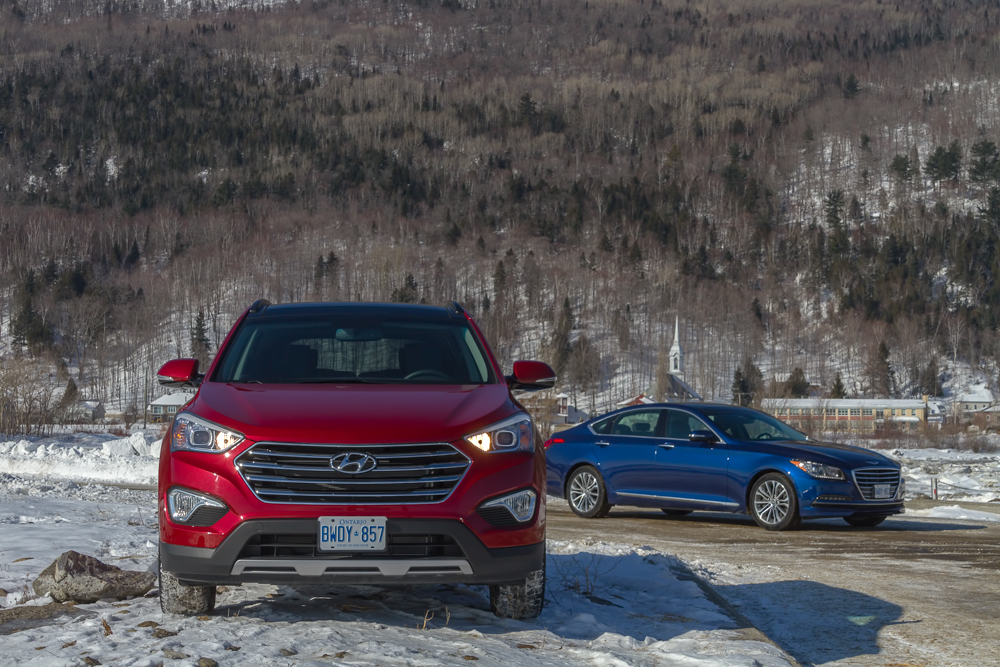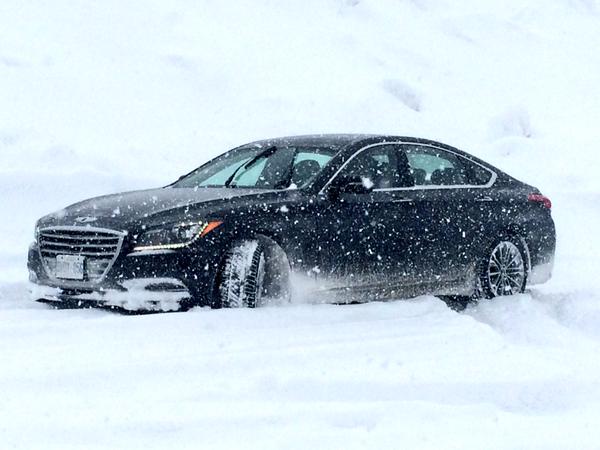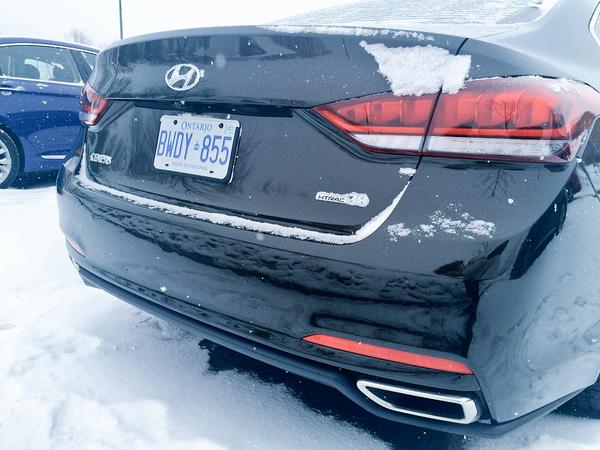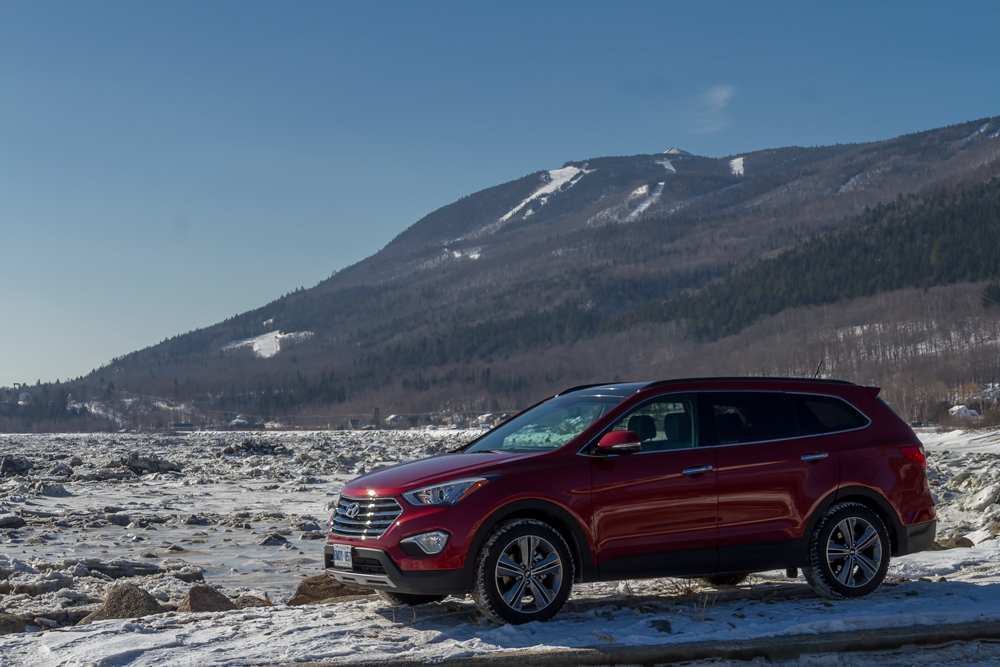Slip-sliding away – and loving it!
- Written by David Taylor
- Published in CAR REVIEWS
- font size decrease font size increase font size
- Be the first to comment!

Baie-Sainte-Paul, Québec – The official invitation from Hyundai Auto Canada Corp. contained the sentence… “This program will expose the Genesis and Santa Fe XL to a wide variety of wintery, public roads and give you the opportunity to fully appreciate the capabilities of Hyundai’s AWD system in a controlled environment.”
As an automotive writer, there was no need to enlist the services of an expert such as the late Alan Turing or any of his dedicated team to decipher this encrypted statement. Translation? Unabashed winter fun and excitement on ice, snow and goodness-knows-all-what in two quite different automobiles – which amounts to (manufacturer sanctioned) drifting!
February in rural Québec may, to some, be the last place to expect Hyundai Canada to demonstrate the features and strengths of two flagship vehicles: the 2015 Hyundai Genesis V6 (second generation); and, the 2015 Hyundai Santa Fe XL – but why sugar coat it? These two disparate vehicles were presented to showcase their cold weather capability and durability in pretty interesting conditions. Did I mention all vehicles driven were with available all-wheel drive (AWD)?
The morning of the event, a group of automotive writers from across Canada were briefed on the virtues of two distinct AWD systems. It had been snowing steadily most of the previous 12 hours or so – and there was no obvious end to the white stuff and sub-zero temperatures in sight. We had, on hand, pretty much perfect conditions to experience… “Snowmageddon”!

The all-wheel systems found in the 2015 Genesis and 2015 Santa Fe XL operate quite differently with diverse, innovative technology – remember, the Genesis is first and foremost rear-wheel drive (RWD) and the Santa Fe front-wheel drive (FWD). Both are, however, designed with the same goals of improving traction and providing driver confidence.
The Hyundai traction (HTRAC) system found in the Genesis was designed specifically for premium sedan applications to provide high levels of performance and control with full-time all-wheel drive featuring a distinct RWD bias. On the other hand, customers in the midsize utility segment are more concerned about utility and traction. For that reason, the Santa Fe XL behaves like a FWD vehicle – until such time as the system detects slippage and sends up to 50 per cent of power to the rear wheels.
Hyundai’s all-new HTRAC active AWD system was developed in conjunction with Magna Powertrain to offer consistent all-weather traction while improving the vehicle’s overall dynamic behaviour. Simply, the HTRAC system electronically controls torque split between the front and rear axles depending on road and driving conditions, offering greater stability on slippery roads – and in corners. The actual power distribution is adjusted depending on the drive mode selected and surface traction.

The FWD 2015 Santa Fe XL features an advanced active AWD system and is so equipped on all but the entry-level model. This sophisticated electronic AWD system automatically activates under any driving condition as needed. Apportioning torque between the front and rear axles in order to optimize traction, it can even anticipate traction requirements. In normal driving, the system distributes power only to the front wheels, helping to reduce fuel consumption. A control unit continuously analyzes data from the vehicle controller and actuates the system through a multi-plate clutch. The AWD system in Santa Fe models incorporates Active Cornering Control (ACC), an element within the Vehicle Stability Management (VSM) system which helps the vehicle manage acceleration in a corner. To improve traction and cornering performance, braking force is applied to the inside rear wheel when accelerating through a turn.
Vehicles and partners assigned, we were to drive south to Le Massif – the mountain, a hugely popular ski resort which presents 770 metres of vertical height – the highest east of the Rocky Mountains. Leaving the relatively warm embrace of Hôtel La Ferme by Le Massif de Charlevoix, some 100 kilometres or so north of Québec City and with poor to non-existent visibility due to driving, practically sideways snow, we tentatively set out. During the whole day of driving, I do not think we ever saw, let alone drove on dry pavement. In spite of the valiant efforts of an occasional plow, the snow continued to accumulate. All participating vehicles were equipped with winter boots – each Genesis, regrettably, was shod with performance-oriented winter tires which, under so-called normal winter circumstances would excel on ice and in cold conditions. Deep snow? Well that’s another tale entirely. Consequently, the HTRAC system really had to be on its game to keep this premium sedan from becoming bogged down.
About 10 to 15 minutes from our starting point, driving cautiously – but with confidence – we came upon a long, slow left hand turn. Manoeuvring into it was no problem. However, almost simultaneously, the rear end began to come loose. Turning into the “drift” only helped to line up the heavy sedan as, in Sam Peckinpah-like slow motion, it careened side-on into a tall and fortunately soft, snow wall on the passenger side. There was an explosion (no, not the noise) of a massive amount of snow that engulfed the sedan as we came to an abrupt – yet safe stop. What ensued was a major case of the giggles as we slowly, and practically blindly, drove out of this natural obstacle and pulled over – none the worse for wear.
At the ski resort and under controlled and well-supervised conditions, we participated in two different run-throughs to test the HTRAC’s abilities. Ice, snow and dirt were to all be part of the “trial” and part of the autocross-style course included an ice section that was too slippery to walk on. Here the Genesis had no issue – even with traction control (TCS) turned off. Whether from a dead stop, or on a slight incline, the HTRAC system would easily allow the wheels to bite into the ice.

Here we also had the chance to test the Santa Fe on a different course – with deeper snow. The mid-size SUV handled each assessment with enthusiasm and confidence. There was never any doubt about its ability to perform in winter conditions. This would be underlined later in the day when we drove from our luncheon stop back to the hotel. The Santa Fe accepted every challenge regardless of the conditions, superbly – and seamlessly. The right rubber for the conditions made all the difference.
While there are differences between both AWD systems, the intent is similar – to provide agility and stability when cornering and traction for slippery and uneven surface roads. Neither automobile as stock vehicles, is intended for off-road capabilities – but percentage-wise, the same may be said for their owners who expect tremendous value for the money – and AWD – in a handsome, performance-oriented package.
Having driven the Genesis in the fall on some rural roads in Ontario I can attest to the cat-like ability of this performance-oriented premium sedan. Similarly, in the interests of full-disclosure I cheerfully have a 2010 Santa Fe Limited in our home driveway. I can say, that the 2015 model would definitely be under serious consideration if I was in the market for a replacement.
The Santa Fe is tried, tested and true – no doubt.
Hyundai wants the Genesis to be taken seriously as a premium yet affordable luxury sedan; having a sophisticated all-wheel drive system is essential. With the right tires, make no mistake that the Genesis will fulfill – and possibly exceed any and all expectations of any individual considering a change in the higher-end luxury AWD sedan category. What’s more, you’ll likely fulfill your list of required performance and features – and still have change – more than enough for a getaway weekend in rural Quebec as you tour the country side in luxury, comfort and safety, stopping off long enough to sample some marvellous cheeses and other local gastronomique delights.
